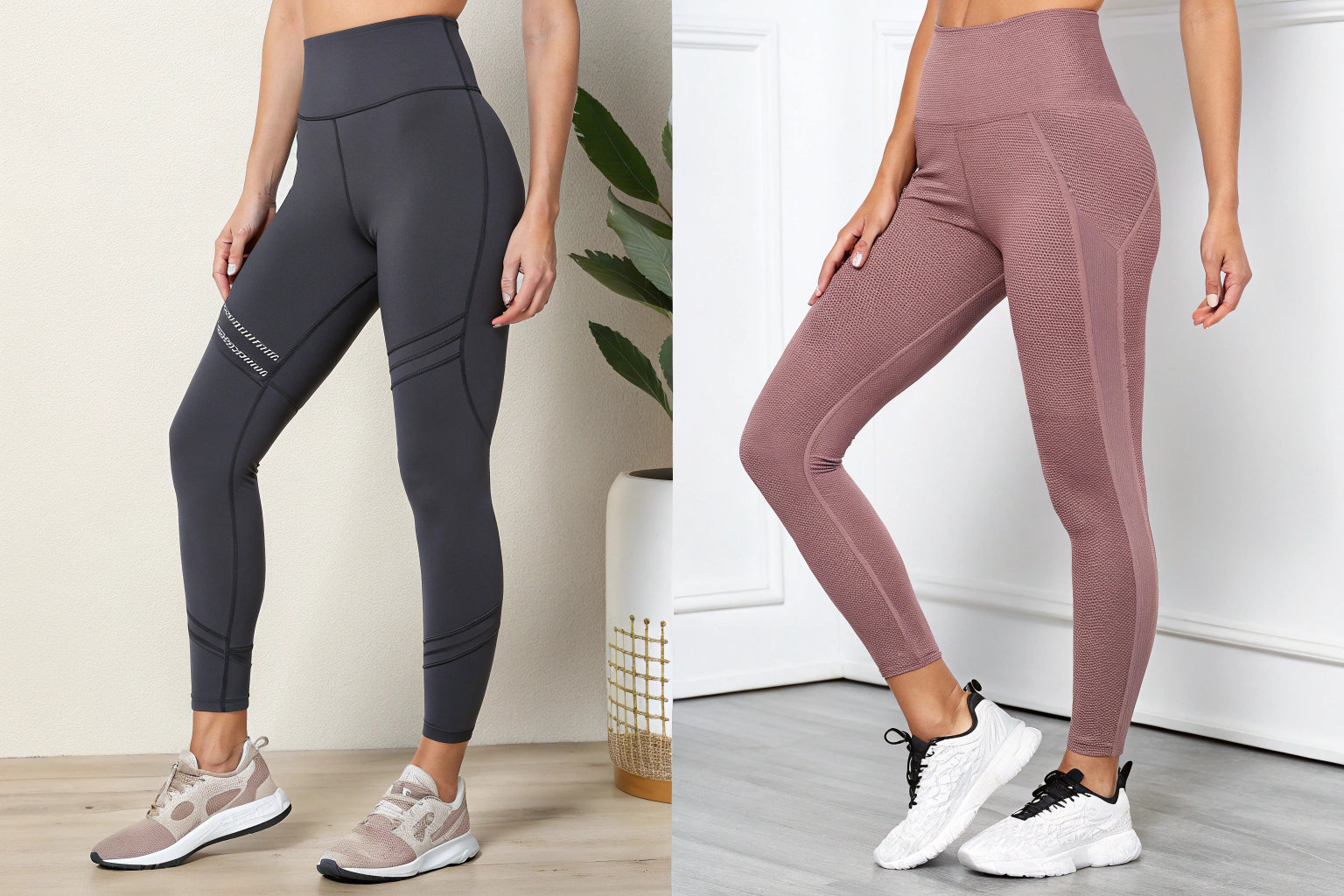Leggings have evolved from being simple fitness gear into one of the most versatile staples in modern wardrobes. They are worn in yoga studios, gyms, offices, and even as part of casual everyday fashion. Because leggings are form-fitting and in constant contact with the skin, the choice of fabric blend directly determines their comfort, durability, and performance. Two of the most popular options on the market today are nylon-spandex and polyester-spandex blends. At first glance, they seem similar, since both contain stretchy spandex (also called elastane or Lycra) that provides excellent flexibility. But the differences between nylon and polyester make each blend perform better in different situations.
In short: Nylon-spandex leggings deliver a silky, luxurious feel that consumers associate with premium activewear brands, while polyester-spandex leggings excel at moisture-wicking, quick-drying, and color retention, making them ideal for high-intensity workouts and outdoor use.
Comfort and Hand-Feel: Which Feels Better?
When shoppers try on leggings, the first thing they notice is the hand-feel—how the fabric feels against the skin.
- Nylon-Spandex: This blend is prized for its silky, smooth, and almost "buttery" texture. It molds to the body, giving a luxurious second-skin feel. This is why high-end yoga brands such as Lululemon and Alo Yoga often rely on nylon blends for their premium collections. Customers often describe nylon leggings as the kind they can wear from morning yoga to brunch, without feeling restricted.
- Polyester-Spandex: While polyester is slightly crisper and less silky than nylon, microfiber polyester has improved dramatically in softness. It provides a lighter and cooler feel, making it well-suited for leggings designed for running, cross-training, or hot yoga where overheating is a concern.
Example: A pair of nylon-spandex leggings might feel like silk against the skin during a slow-flow yoga class, while polyester-spandex leggings will feel cool and breathable during a 10K run on a warm afternoon.
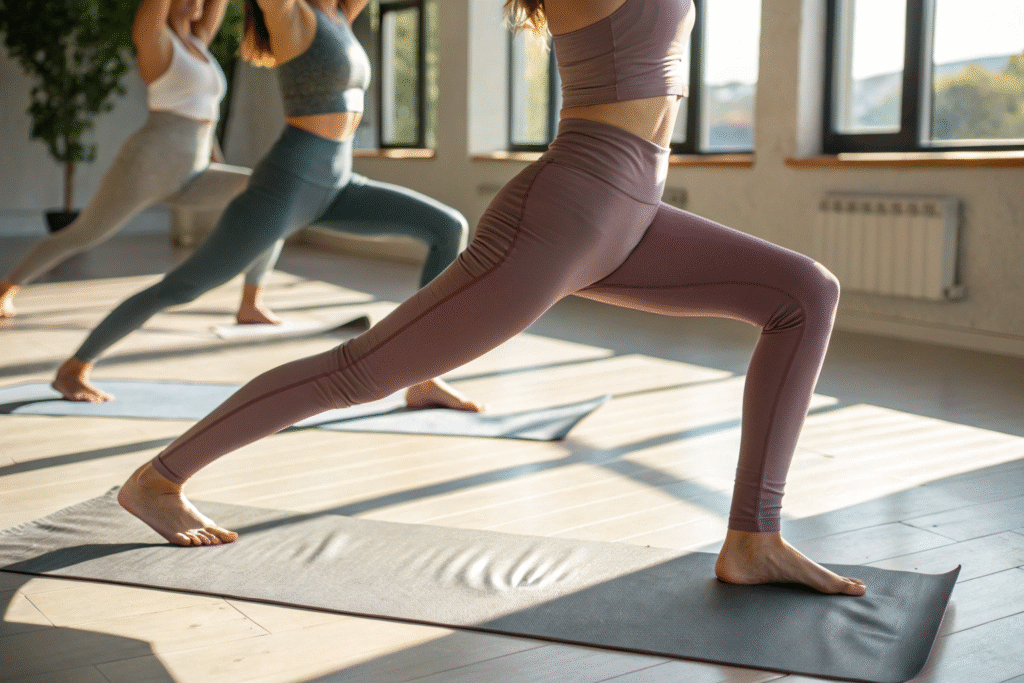
Why Do Yoga Enthusiasts Prefer Nylon?
Because yoga involves slow, controlled movements and poses where comfort, stretch, and softness matter most. Nylon’s silky touch provides confidence and ease, even in close-fitting positions.
Why Do Runners Prefer Polyester?
Because polyester stays drier and lighter over long runs, reducing discomfort caused by sweat buildup. Runners often report that polyester leggings feel more breathable during extended training sessions.
Sweat and Moisture Management: Which Performs Better?
Sweat handling is one of the most important factors in activewear performance.
- Nylon: Absorbs up to 10% of its own weight in water. This means nylon leggings can feel heavier and slightly damp during sweat-heavy activities. They also take longer to dry after washing. For example, after a hot yoga class, nylon leggings may cling to the skin and need hours to dry on the rack.
- Polyester: Absorbs less than 1% of water. It is naturally hydrophobic, which means sweat is pushed to the fabric’s surface to evaporate quickly. This property makes polyester the go-to choice for leggings designed for high-intensity workouts like HIIT, running, or spin classes. Polyester leggings can dry within minutes under normal airflow, allowing athletes to feel more comfortable.
Industry data: Tests conducted by the American Association of Textile Chemists and Colorists (AATCC) showed that polyester fabrics dried on average 35% faster than comparable nylon fabrics under the same conditions.
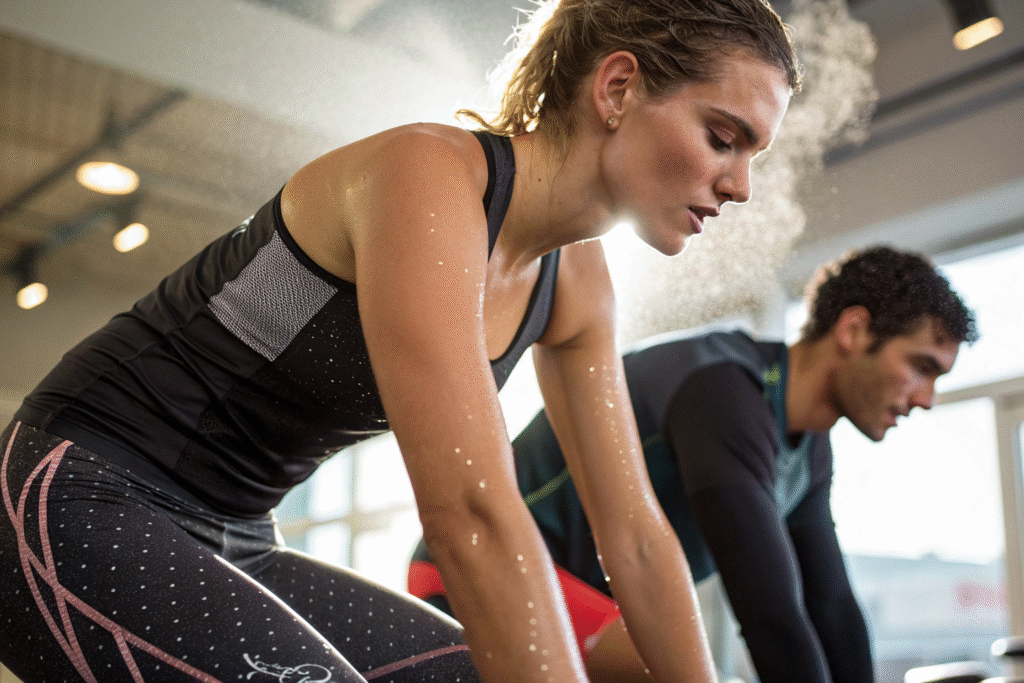
Why Is Polyester Better for Sweat-Heavy Workouts?
Because polyester’s hydrophobic properties prevent fabric from absorbing moisture into the fibers. Instead, sweat spreads across the surface, where it can evaporate quickly.
Can Nylon Be Modified for Better Moisture Management?
Yes. Some nylon fabrics are treated with moisture-wicking finishes or blended with polyester to improve performance. However, polyester remains the naturally superior fiber for moisture management.
Durability and Pilling: Which Lasts Longer?
Both nylon and polyester are durable, but they excel in different ways.
- Nylon: Has higher tensile strength and elasticity, making it harder to tear. That’s why nylon leggings are resistant to sudden rips or overstretching, even in extreme poses. However, nylon tends to pill faster—forming small fuzzy balls on the fabric surface after friction, especially in areas like the thighs or seat.
- Polyester: Slightly less strong in raw tensile tests, but it resists pilling better than nylon. This means polyester leggings maintain a smoother, newer appearance even after dozens of washes.
Example: A pair of nylon-spandex leggings may last years without tearing but start to show surface fuzz after six months of frequent wear. Polyester-spandex leggings, on the other hand, may feel less luxurious but stay visually smooth for longer.
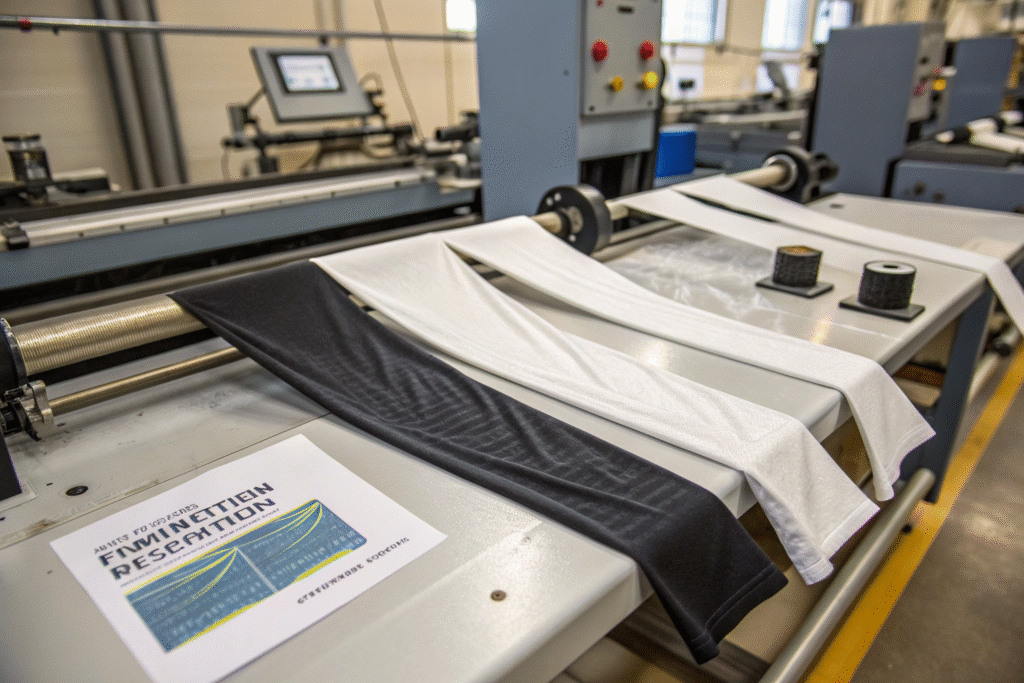
Why Do Premium Brands Still Choose Nylon?
Because their customers prioritize comfort and stretch over long-term appearance. High-end buyers are often willing to accept some pilling in exchange for that silky, premium feel.
Why Do Mid-Range Brands Prefer Polyester?
Because polyester is easier to mass-produce, resists pilling, and maintains color vibrancy. This makes it the smarter choice for budget-conscious consumers who want leggings that look newer longer.
UV Protection and Color Retention: Which Holds Up Better Outdoors?
Exposure to sunlight and repeated washing affect the look of leggings.
- Nylon: More vulnerable to UV damage. Prolonged sun exposure causes yellowing and fiber breakdown. Nylon leggings may also fade more quickly when dyed in bright shades.
- Polyester: Highly resistant to UV degradation and excellent at holding dyes. Printed or brightly colored polyester leggings remain vibrant after months of outdoor use and frequent washing.
Example: A pair of printed polyester-spandex leggings used for outdoor running may retain 90% of its original vibrancy after 50 washes, while a nylon-spandex pair may appear faded under the same conditions.
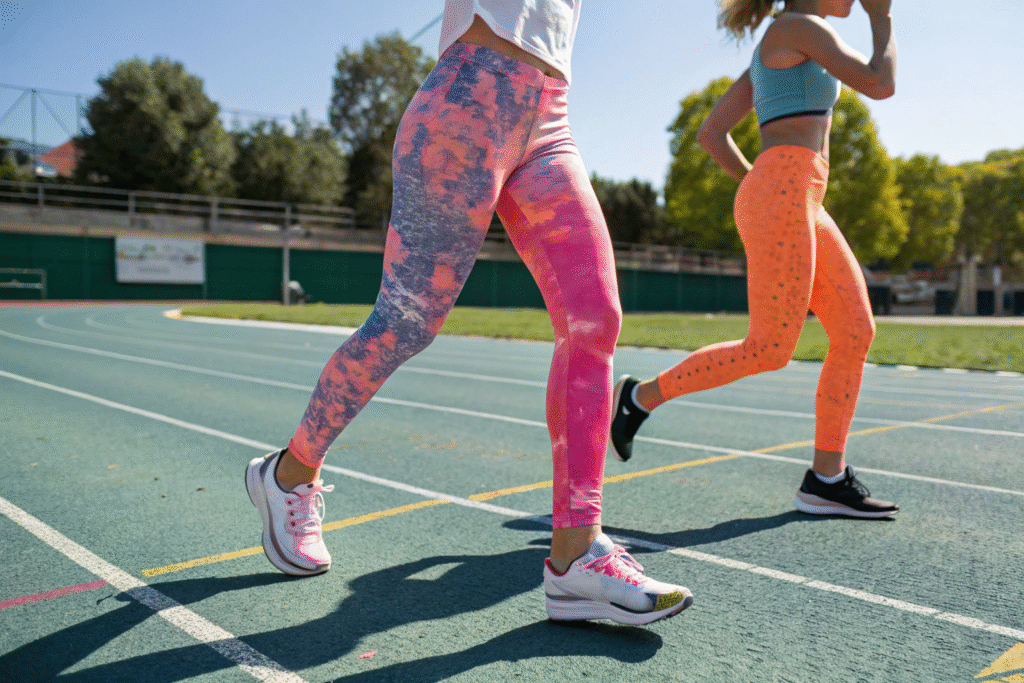
Why Is Polyester Better for Outdoor Leggings?
Because polyester fibers are inherently resistant to UV rays and dye fading, making them ideal for running tights, hiking gear, and outdoor training leggings.
Why Do Indoor Fitness Brands Favor Nylon?
Because in controlled environments like gyms or yoga studios, UV exposure is not a concern, and comfort is prioritized over long-term colorfastness.
Cost and Market Positioning: Which Is Smarter for Buyers?
- Nylon-Spandex: More expensive due to higher production costs. This blend is often marketed as luxury activewear, targeting consumers who are willing to pay for premium softness. For instance, leggings priced between $90–$120 in high-end stores are usually nylon-based.
- Polyester-Spandex: More cost-effective and accessible, making it the dominant choice for mid-range and mass-market brands. Many leggings sold between $25–$50 are polyester-based. With the addition of recycled polyester (rPET), these leggings can also be positioned as eco-friendly.
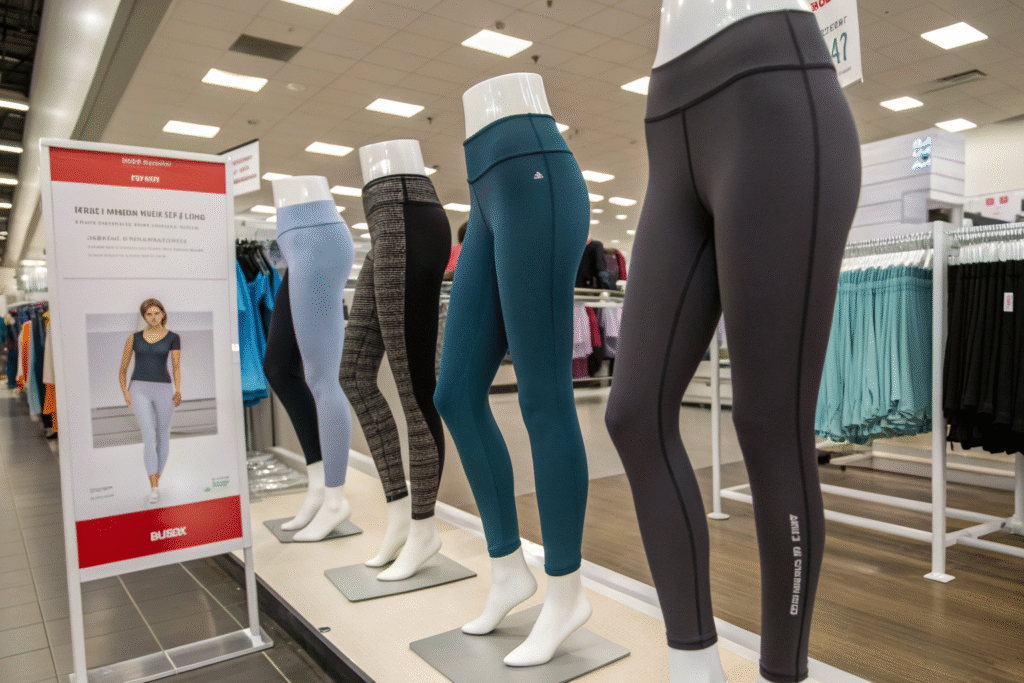
Why Do High-End Brands Invest in Nylon?
Because their core consumers value comfort, exclusivity, and fabric performance. Nylon-spandex leggings often become a brand’s hero product, used in flagship collections.
Why Do Affordable Brands Favor Polyester?
Because polyester offers consistent quality, affordability, and mass-production efficiency. This makes it possible to target wider audiences without compromising performance.
Conclusion
The choice between nylon-spandex and polyester-spandex leggings depends on the target market and intended use.
- Nylon-spandex leggings: Best for yoga, pilates, and athleisure fashion where comfort, luxury feel, and stretch are the top priorities. They are ideal for premium brands that want to position themselves at the high end of the market.
- Polyester-spandex leggings: Best for running, gym training, and outdoor activities where moisture management, quick-drying, and color retention matter more. They are ideal for mass-market or performance-driven brands aiming at affordability and durability.
For buyers and fashion entrepreneurs, the smartest strategy may be to offer both options—nylon for premium collections and polyester for mainstream or outdoor lines.
At Shanghai Fumao, we produce both nylon-spandex and polyester-spandex leggings fabrics, with certified testing, recycled material options, and rapid sampling services. If you want to develop your next leggings collection with confidence in both quality and performance, contact our Business Director Elaine at elaine@fumaoclothing.com today.

